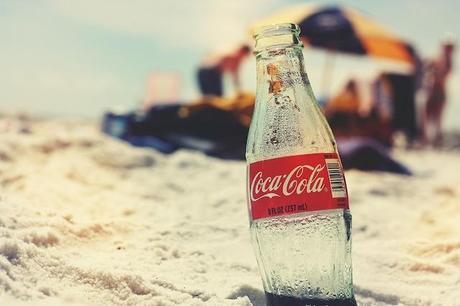Coca-Cola Makes It To The Top Position Again in The Global Audit of Plastic Trash, Becoming The Most Polluting Brand Consecutively
Once more, COCA-COLA became the most polluting brand, making it for the second time in a row in a global audit of plastic trash, which is conducted every year by the Break Free From Plastic global movement. This giant soda company contributed to plastic litter more than the combined pollution caused by the next top three polluters.
One-day clean-up programme conducted in September involving 72,000 volunteers and more who fanned out onto beaches, waterways, and streets adjacent to offices and homes and picked up plastic bottles, bags, cups, wrappers, and scraps for the audit. The 50 different types of plastic were sorted out through the mounds of garbage, and they could be traced back to nearly 8,000 brands. Plastic litter of 11,732 pieces found in 37 countries on four continents belonged to Coke. After Coca-Cola, Nestle, PepsiCo, Mondelez International (snack brands like Oreo, Ritz, Nabisco, and Nutter Butter), and Unilever were the next biggest contributors to the plastic pollution in the audit. However, in more than 50% of cases, it was impossible to identify the brand of plastic litter.

Coke was the largest source of plastic in Africa and Europe and the second-largest in Asia and South America. In North America, the Nestle company was responsible for the most plastic found in the clean-ups, followed by the Solo Cup Company(owned by the Dart Container corporation), and Starbucks. Coca-Cola holds fifth place in North America.
Coca-Cola responded to questions with an emailed statement: “Any time our packaging ends up in our oceans — or anywhere that it doesn’t belong — is unacceptable to us. In partnership with others, we are working to address this critical global issue, both to help turn off the tap in terms of plastic waste entering our oceans and to help clean up the existing pollution.”
Coke’s statement also said, “We are investing locally in every market to increase recovery of our bottles and cans and recently announced the launch in Vietnam of an industry-backed packaging recovery organization, as well as a bottler-led investment of $19 million in the Philippines in a new food-grade recycling facility. We are also investing to accelerate key innovations that will help to reduce waste, including new enhanced recycling technologies that allow us to recycle poor quality PET plastic, often destined for incineration or landfill, back to high quality food packaging material.”
On the one hand, Coca-Cola is found as the top global contributor to plastic waste for two consecutive years in the audit. On the other hand, it curated public image as an environmental leader very carefully. Earlier this month, a plastic bottle made from recycled marine plastic was introduced by Coke, and the company pledged to collect and recycle “the equivalent of every bottle or can it sells globally” last year.
Coca-Cola’s green image is getting distorted with the company’s massive trail of garbage, other recent evidence. Leaked audio obtained by The Intercept disclosed how Coke-funded organizations undermine bottle bills. The company has also been interfering with the efforts of the European environmentalists closely aligned with the advocates conducting the global brand audit to combat plastic pollution.
Cities and towns in hundreds have recently committed to becoming “zero waste” cities. “We have created a very detailed master plan, which looks at the complete picture at what a municipality needs to reduce their waste,” according to Alexandra Aubertin, founder of Zero Waste Montenegro and board member of Zero Waste Europe. “We look at everything that has been done in a city but also see a local level how things can be reused.” In the zero waste movement, reduction and conservation of plastic and other materials come first on a hierarchy above recycling and emphasizes the reduction of waste at its source.
However, last October, zero waste advocates noticed another namesake effort with very different goals. This new zero-waste didn’t have a comprehensive approach to reducing waste but seemed designed “to confuse people on the zero waste hierarchy,” said Aubertin. It was “telling people the solution is recycling. But that’s not what the zero waste hierarchy is all about.”
Aubertin was shocked to find that this new “zero waste” messaging was coming from the world’s biggest plastic polluter Coca-Cola itself. She first came to know about the campaign from one of her Greek colleagues after the announcement was made from the company to help make “Thessaloniki, the second-biggest city in Greece, the first city in the country with the potential to become a zero-waste municipality.”
Successively Coke announced its funding for another “zero waste” initiative in her own country in March in the city of Budva. Coca-Cola announced on the Serbian website, and the company is funding a Montenegrin nonprofit whose name translates to “NGO Eco Center from Budva” — “with the aim of becoming the first coastal Adriatic city without waste.” An “interactive center” created with the fund to make visitors aware about ecology and to fund a “Capture the Clean Wave” program that will “contribute to the collection of packaging waste at more than 40 beaches in the Budva Riviera.”
It also funded door-to-door education about recycling and for bins for capturing PET plastic bottles, according to Zero Waste Montenegro. However, their Coke-funded efforts were sadly inadequate.
“Even if it would capture all the PET bottles put on the market in Budva,” the organization wrote on its website, “it is only one small part of the waste being produced in Budva every year. It wouldn’t make Budva a Zero Waste City.”

